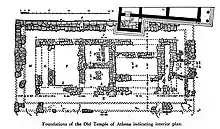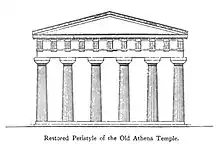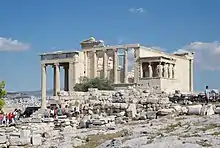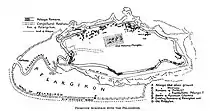Old Temple of Athena
The Old Temple of Athena was an Archaic temple located on the Acropolis of Athens between the Older Parthenon and Erechtheion, built around 525–500 BC, and dedicated to Athena Polias, the patron deity of the city of Athens. It was destroyed by the Persians in 480 BC, during the Destruction of Athens. It was located at the center of the Acropolis plateau, probably on the remains of a Mycenaean palace. The complex is sometimes described by the name "Dörpfeld foundations", after the archaeologist who found the location of the temple. It was referred to as "Archaios Neos" (Old Temple) by the Greeks.
| Old temple of Athena Polias (Archaios Neos) | |
|---|---|
 Central figure of the pediment of the temple | |
 Location within Greece | |
| General information | |
| Type | Temple |
| Architectural style | Ancient Greek Archaic |
| Location | Athens, Greece |
| Coordinates | 37.9715°N 23.7267°E |
| Current tenants | Museum of the Acropolis |
| Construction started | ca. 525 BC |
| Completed | ca. 500 BC (for the worship of Athena) |
| Destroyed | 480 BC (Persian Wars) |
| Owner | Greek government |
| Technical details | |
| Size | 21.3 m by 43.15 m |
Description
Temple Plan
.jpg.webp)



The foundations suggest the following basic description: the temple measured 21.3 by 43.15 m. It was surrounded by a peristasis of 6 by 12 columns. The difference between column axes was 4.04 m, narrowed by 0.31 m at the corners. The Stylobate was slightly curved, whether this also applied to the superstructure remains unclear. In both the pronaos and opisthodomos, two columns stood between short antae. The main building had two inner sanctums, the east cella and the west cella,[1] which was very short, in fact nearly square, and subdivided into three aisles by two rows of three columns each. It was followed by a pair of side-by-side rooms. The foundations were composed of various materials and constructed in varying techniques. While the load-bearing parts and internal supports were made of blue Acropolis limestone,[1] the foundations of the surrounding peristasis were of Poros limestone. The superstructure and decorative pieces also appear to have been made from a variety of materials, including Poros and Parian marble.
Pediments
The old temple of Athena had two Poros pediments, around 15 m. in length.[2] The surviving pediment depicts Gigantomachy, the struggle between Gods and Giants, eventually won by the Gods. The central figure depicts the goddess Athena wearing an aegis covered with scales and edged by snakes obtained from a monster she previously defeated. She is thought to hit a falling Giant, whose foot is the only remain.[2] Scholars believe that this pediment originally contained a frontal chariot in the center with four horses and Zeus inside one of the chariot, pointing an arrow in the direction of Athena.[3] This images also shows Athena holding a snake and reaching out to a giant.[1]
Another figure features a lying giant, whereas two side figures, one was positioned at the corners of the pediment, depict two more falling giants. Other remains ascribed to the temple include an entablature and sima of Parian marble and Poros limestone, capitals with a steep echinus, a marble sculpture depicting a procession, and marble waterspouts in each of the four corners, shaped like lions' and rams' heads.[1]
Xoanon
The main building of the temple had two parts, one of the spaces in the east Cella contained the ancient Xoanon or wooden statue of Athena, believed to have fallen from the sky,[1] or from Zeus.[2] The statue was probably taken to the Athenian fleet ('the wooden wall') and was therefore not destroyed when the Persians destroyed the old Temple of Athena Polias in 480 BC. It was eventually housed in the new temple of Athena Polias - the Erechtheion. The Xoanon statue was made out of olive-wood.[1]
 Slab of frieze of Old Athena Temple
Slab of frieze of Old Athena Temple Athena fighting the giants (pediment).
Athena fighting the giants (pediment). One of the two west pediment Gigantomachy
One of the two west pediment Gigantomachy Athena fighting the giants (pediment).
Athena fighting the giants (pediment). Old Temple of Athena, pediment giant.
Old Temple of Athena, pediment giant.
Excavation and Reconstruction
Wilhelm Dörpfeld


Wilhelm Dörpfeld went to Athens in 1885[5] to look at the ruins of the Temple of Athena where he noticed some ruins were still standing and looked as though the architecture was the temple of Athena Polias.[5] Wilhelm saw a piece of a building that looked like a piece of the Erechtheiom temple, which was in the same location another archaeologist named Ross excavated in 1834.[5] Once Wilhelm saw the same ruins he cleared in 1834, Wilhelm went towards the ruins to examine and he immediately confirmed it was the old temple of Athena.[5] Wilhelm Dörpfeld assumed that the original structure was a double temple in antis, dating to about 570 BC, lengthened and broadened by the addition of the peristasis under Peisistratus, between 529 and 520 BC.[6] This idea led to a subdivision of the foundations into an inner smaller structure known as H-Architektur and assumed to be the oldest part of the building, followed by a structure still described as the "Old Temple of Athena", including the inner H-Architektur as well as the external peristasis.
Other scholars

The reconstruction of the temple's architectural history has remained controversial until recently. More recently, scholars have attributed the older remains, initially attributed to the inner H-Architektur, to the close Hekatompedon temple, dating the temple of Athena Polias to the last third of the 6th century BC and identifying its dimensions with the entirety of the foundations excavated by Dörpfeld.[7] The Old Temple of Athena Polias is often dated to[6] 510/500 BC.[8] There are many speculations that the old temple of Athena was rebuilt by the Athenians once they took over Athens again.[5] Frazer and Michaelis believe that the temple was not the old temple of Athena but, a new temple in the same location where the Erechtheion stood.[5] There were other scholars that did not agree with Dörpfeld's suggestion that the old temple of Athena was rebuilt and that the building was destroyed. Bates believes that Dörpfeld is correct with his discovery of the architecture and that it was indeed rebuilt.[5] Ferrari mentions that Bates took Dörpfeld's side on his excavation for lost treasure in the old temple of Athena, but the temple was not built right away as Dörpfeld thought it was.[5] Pericles (495-429 B.C.) who was a general and a politician to Athens citizens was the one who convinced the Athenian people to rebuild the Temples of Athena. He suggested to the Athenians not to have the location be a pile of rubble where the temple once stood because that could offend the gods.[5] It remains controversial whether a partial restoration of the temple followed the Persian sack of 480 BC. Herodotus[9] mentions a west-facing Megaron on the Acropolis. This reference, as well as a structure listed in an inscription,[10] has been interpreted as evidence that the Opisthodomus of the Old Temple remained in place through the fifth century. Xenophon[11] states that the Old Temple of Athena burned down in 406/405 BC, but this might also refer to the Erechtheion, which had taken over the functions of the Old Temple and housed the Xoanon.[9] From the 4th century BC onwards, there are no possible references to the Old Temple; Pausanias was not aware of its existence.
.jpg.webp) Section of the Acropolis with Old Temple of Athena (reconstitution).
Section of the Acropolis with Old Temple of Athena (reconstitution). Plan of the Old Temple of Athena.
Plan of the Old Temple of Athena. Location of the Temple on the Acropolis.
Location of the Temple on the Acropolis.
Bibliography
- Wilhelm Dörpfeld: Der alte Athenatempel auf der Akropolis. In: Mitteilungen des Deutschen Archäologischen Institus, Abteilung Athen. Vol. 11, 1886, p. 337–51.
- Wilhelm Dörpfeld: Der alte Athenatempel auf der Akropolis II. In: Mitteilungen des Deutschen Archäologischen Institus, Abteilung Athen. Vol. 12 (1887), 25–61. 190–211
- Wilhelm Dörpfeld: Das Hekatompedon in Athen. In: Jahrbuch des Deutschen Archäologischen Institus. Vol. 34, 1919, p. 1–40.
- William B. Dinsmoor: The Hekatompedon on the Athenian Acropolis. In: American Journal of Archaeology. Vol. 51, 1947, p. 109–51
- I. Beyer: Die Datierung der großen Reliefgiebel des Alten Athenatempels der Akropolis. In: Archäologischer Anzeiger. 1977, p. 44–74.
- William A. P. Childs: The Date of the Old Temple of Athena on the Athenian Acropolis. In: William D. E. Coulson et al. (eds.): The Archaeology of Athens and Attica under the Democracy. Proceedings of an International Conference celebrating 2500 years since the birth of democracy in Greece, held at the American School of Classical Studies at Athens, December 4–6, 1992. Oxford 1994, p. 1–6.
- Manolis Korres: Die Athena-Tempel auf der Akropolis. In: Wolfram Hoepfner (ed.): Kult und Kultbauten auf der Akropolis. Internationales Symposion vom 7. bis 9. Juli 1995 in Berlin. Berlin 1997, p. 218–43.
- Gloria Ferrari: The Ancient Temple on the Acropolis at Athens. In: American Journal of Archaeology. Vol. 106, 2002, p. 11–35.
- Stamatia Eleftheratou, Acropolis Museum, guide, Acropolis Museum Editions, Athens 2014
See also
References
- Brouskai, Maria (1997). The Monuments of the Acropolis. Athens: Archaeological Receipts Fund. pp. 302–211.
- Frantzi, Helen (1970). The Acropolis. Athens: Voutsas. pp. 5–92.
- Moore, Mary (1995). "The Central Group in the Gigantomachy of the Old Athena Temple on the Acropolis". American Journal of Archaeology. 99 (4): 633–639. doi:10.2307/506186. JSTOR 506186.
- Old Temple of Athena, museum notice. 2019.
- Ferrari, Gloria (2002). "The Ancient Temple on the Acropolis at Athens". American Journal of Archaeology. 106 (1): 11–35. doi:10.2307/507187. JSTOR 507187.
- Wilhelm Dörpfeld: Der alte Athenatempel auf der Akropolis. In: Mitteilungen des Deutschen Archäologischen Institus, Abteilung Athen. Vol. 11, 1886, p. 337–51; Wilhelm Dörpfeld: Der alte Athenatempel auf der Akropolis II. In: Mitteilungen des Deutschen Archäologischen Institus, Abteilung Athen. Vol. 12 (1887), 25–61. 190–211; Wilhelm Dörpfeld: Das Hekatompedon in Athen. In: Jahrbuch des Deutschen Archäologischen Institus. Vol. 34, 1919, p. 1–40; William B. Dinsmoor: The Hekatompedon on the Athenian Acropolis. In: American Journal of Archaeology. Vol. 51, 1947, p. 109–51.
- Manolis Korres: Die Athena-Tempel auf der Akropolis. In: Wolfram Hoepfner (ed.): Kult und Kultbauten auf der Akropolis. Internationales Symposion vom 7. bis 9. Juli 1995 in Berlin. Berlin 1997, p. 218–43; Stamatia Eleftheratou: “Acropolis Museum, guide”, Acropolis Museum Editions, Athens 2014, p. 116-23
- William A. P. Childs: The Date of the Old Temple of Athena on the Athenian Acropolis. In: William D. E. Coulson u.a. (eds.): The Archaeology of Athens and Attica under the Democracy. Proceedings of an International Conference celebrating 2500 years since the birth of democracy in Greece, held at the American School of Classical Studies at Athens, December 4–6, 1992. Oxford 1994, p. 1–6; suggesting a date before 520: Manolis Korres: Die Athena-Tempel auf der Akropolis. In: Wolfram Hoepfner (ed.): Kult und Kultbauten auf der Akropolis. Internationales Symposion vom 7. bis 9. Juli 1995 in Berlin. Berlin 1997, p. 218–43
- Herodotus 5, 77.
- Inscriptiones Graecae I² 91/92.
- Xenophon, Hellenika 1, 6, 1.
External links
| Wikimedia Commons has media related to Old Temple of Athena. |
.jpg.webp)